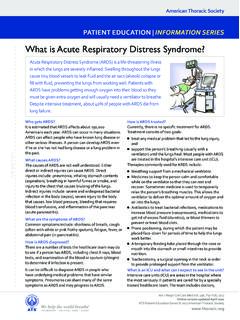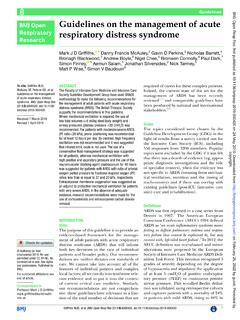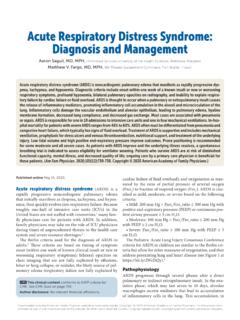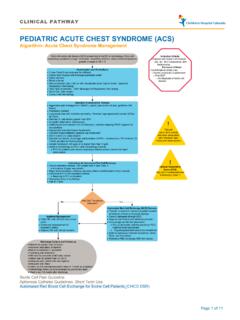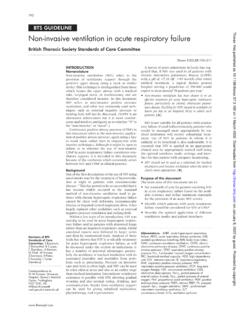Transcription of Clinical management of severe acute respiratory infection ...
1 Clinical management of severe acute respiratory infection (SARI) when COVID-19 disease is suspected Interim guidance 13 March 2020 This is the second edition (version ) of this document, which was originally adapted from Clinical management of severe acute respiratory infection when MERS-CoV infection is suspected (WHO, 2019). It is intended for clinicians involved in the care of adult, pregnant, and paediatric patients with or at risk for severe acute respiratory infection (SARI) when infection with the COVID-19 virus is suspected. Considerations for paediatric patients and pregnant women are highlighted throughout the text. It is not meant to replace Clinical judgment or specialist consultation but rather to strengthen Clinical management of these patients and to provide up-to-date guidance. Best practices for infection prevention and control (IPC), triage and optimized supportive care are included. This document is organized into the following sections: 1. Background 2.
2 Screening and triage: early recognition of patients with SARI associated with COVID-19 3. Immediate implementation of appropriate IPC measures 4. Collection of specimens for laboratory diagnosis 5. management of mild COVID-19: symptomatic treatment and monitoring 6. management of severe COVID-19: oxygen therapy and monitoring 7. management of severe COVID-19: treatment of co-infections 8. management of critical COVID-19: acute respiratory distress syndrome (ARDS) 9. management of critical illness and COVID-19: prevention of complications 10. management of critical illness and COVID-19: septic shock 11. Adjunctive therapies for COVID-19: corticosteroids 12. Caring for pregnant women with COVID-19 13. Caring for infants and mothers with COVID-19: IPC and breastfeeding 14. Care for older persons with COVID-19 15. Clinical research and specific anti-COVID-19 treatments Appendix: resources for supporting management of SARI in children These symbols are used to flag interventions: Do: the intervention is beneficial (strong recommendation) OR the intervention is a best practice statement.
3 Don t: the intervention is known to be harmful. Consider: the intervention may be beneficial in selected patients (conditional recommendation) OR be careful when considering this intervention. This document provides clinicians with updated interim guidance on timely, effective, and safe supportive management of patients with suspected and confirmed COVID-19. The definitions of mild and severe illness are in Table 2. Those with critical illness are defined as patients with acute respiratory distress syndrome (ARDS) or sepsis with acute organ dysfunction. The recommendations in this document are derived from WHO publications. Where WHO guidance is not available, we refer to evidence-based guidelines. Members of a WHO global network of clinicians and clinicians who have treated patients with SARS, MERS, or severe influenza have reviewed the recommendations (see Acknowledgements). For queries, please email: with COVID-19 Clinical question in the subject line. Background Coronavirus disease 2019 (COVID-19) is a respiratory tract infection caused by a newly emergent coronavirus , that was first recognized in Wuhan, China, in December 2019.
4 Genetic sequencing of the virus suggests that it is a betacoronavirus closely linked to the SARS virus (1). While most people with COVID-19 develop only mild or uncomplicated illness, approximately 14% develop severe disease that requires hospitalization and oxygen support, and 5% require admission to an intensive care unit (1). In severe cases, COVID-19 can be complicated by the acute respiratory distress syndrome (ARDS), sepsis and septic shock, multiorgan failure, including acute kidney injury and cardiac injury (2). Older age and co-morbid disease have been reported as risk factors for death, and 2 Clinical management of severe acute respiratory infection (SARI) when COVID-19 disease is suspected: Interim guidance recent multivariable analysis confirmed older age, higher Sequential Organ Failure Assessment (SOFA) score and d-dimer > 1 g/L on admission were associated with higher mortality. This study also observed a median duration of viral RNA detection of days (IQR ) in survivors, but COVID-19 virus was detectable until death in non-survivors.
5 The longest observed duration of viral shedding in survivors was 37 days (3, 4). Building on evidence-informed guidelines developed by a multidisciplinary panel of health care providers with experience in the Clinical management of patients with COVID-19 and other viral infections, including SARS and MERS, as well as sepsis and ARDS, this guidance should serve as a foundation for optimized supportive care to ensure the best possible chance for survival and to allow for reliable comparison of investigational therapeutic interventions as part of randomized controlled trials (5, 6). There are few data on the Clinical presentation of COVID-19 in specific populations, such as children and pregnant women. In children with COVID-19 the symptoms are usually less severe than adults and present mainly with cough and fever, and co- infection has been observed (7, 8). Relatively few cases have been reported of infants confirmed with COVID-19; those experienced mild illness (9). There is currently no known difference between the Clinical manifestations of COVID-19 pregnant and non-pregnant women or adults of reproductive age.
6 Pregnant and recently pregnant women with suspected or confirmed COVID-19 should be treated with supportive and management therapies, as described below, taking into account the immunologic and physiologic adaptations during and after pregnancy. 1. Screening and triage: early recognition of patients with SARI associated with COVID-19 Screening and triage: Screen and isolate all patients with suspected COVID-19 at the first point of contact with the health care system (such as the emergency department or outpatient department/clinic). Consider COVID-19 as a possible etiology of patients with acute respiratory illness under certain conditions (see Table 1). Triage patients using standardized triage tools and start first-line treatments. Remark 1: Although the majority of people with COVID-19 have uncomplicated or mild illness (81%), some will develop severe illness requiring oxygen therapy (14%) and approximately 5% will require intensive care unit treatment. Of those critically ill, most will require mechanical ventilation (2, 10).
7 The most common diagnosis in severe COVID-19 patients is severe pneumonia. Remark 2: Early recognition of suspected patients allows for timely initiation of appropriate IPC measures (see Table 3). Early identification of those with severe illness, such as severe pneumonia (see Table 2), allows for optimized supportive care treatments and safe, rapid referral and admission to a designated hospital ward or intensive care unit according to institutional or national protocols. Remark 3: Older patients and those with comorbidities, such as cardiovascular disease and diabetes mellitus, have increased risk of severe disease and mortality. They may present with mild symptoms but have high risk of deterioration and should be admitted to a designated unit for close monitoring. Remark 4: For those with mild illness, hospitalization may not be required unless there is concern about rapid deterioration or an inability to promptly return to hospital, but isolation to contain/mitigate virus transmission should be prioritized.
8 All patients cared for outside hospital ( at home or non-traditional settings) should be instructed to manage themselves appropriately according to local/regional public health protocols for home isolation and return to a designated COVID-19 hospital if they get worse ( (ncov)- infection -presenting-with-mild-sy mptoms-and- management -of-contacts). Table 1. Definitions of SARI and surveillance case definitions for COVID-19* Surveillance case definitions for COVID-19* Suspect case See latest WHO case definitions for suspect case of COVID-19* Confirmed case A person with laboratory confirmation of COVID-19 infection , irrespective of Clinical signs and symptoms. * See Global Surveillance for human infection with coronavirus disease (COVID-19) for latest case definitions. 3 Clinical management of severe acute respiratory infection (SARI) when COVID-19 disease is suspected: Interim guidance Table 2. Clinical syndromes associated with COVID-19 Mild illness Patients uncomplicated upper respiratory tract viral infection may have non-specific symptoms such as fever, fatigue, cough (with or without sputum production), anorexia, malaise, muscle pain, sore throat, dyspnea, nasal congestion, or headache.
9 Rarely, patients may also present with diarrhoea, nausea, and vomiting (3, 11-13). The elderly and immunosuppressed may present with atypical symptoms. Symptoms due to physiologic adaptations of pregnancy or adverse pregnancy events, such as dyspnea, fever, GI-symptoms or fatigue, may overlap with COVID-19 symptoms. Pneumonia Adult with pneumonia but no signs of severe pneumonia and no need for supplemental oxygen. Child with non- severe pneumonia who has cough or difficulty breathing + fast breathing: fast breathing (in breaths/min): < 2 months: 60; 2 11 months: 50; 1 5 years: 40, and no signs of severe pneumonia. severe pneumonia Adolescent or adult: fever or suspected respiratory infection , plus one of the following: respiratory rate > 30 breaths/min; severe respiratory distress ; or SpO2 93% on room air (adapted from 14). Child with cough or difficulty in breathing, plus at least one of the following: central cyanosis or SpO2 < 90%; severe respiratory distress ( grunting, very severe chest indrawing); signs of pneumonia with a general danger sign: inability to breastfeed or drink, lethargy or unconsciousness, or convulsions (15).
10 Other signs of pneumonia may be present: chest indrawing, fast breathing (in breaths/min): < 2 months: 60; 2 11 months: 50; 1 5 years: 40 (16). While the diagnosis is made on Clinical grounds; chest imaging may identify or exclude some pulmonary complications. acute respiratory distress syndrome (ARDS) (17-19) Onset: within 1 week of a known Clinical insult or new or worsening respiratory symptoms. Chest imaging (radiograph, CT scan, or lung ultrasound): bilateral opacities, not fully explained by volume overload, lobar or lung collapse, or nodules. Origin of pulmonary infiltrates: respiratory failure not fully explained by cardiac failure or fluid overload. Need objective assessment ( echocardiography) to exclude hydrostatic cause of infiltrates/oedema if no risk factor present. Oxygenation impairment in adults (17, 19): Mild ARDS: 200 mmHg < PaO2/FiO2a 300 mmHg (with PEEP or CPAP 5 cmH2O, or non-ventilated) Moderate ARDS: 100 mmHg < PaO2/FiO2 200 mmHg (with PEEP 5 cmH2O, or non-ventilated) severe ARDS: PaO2/FiO2 100 mmHg (with PEEP 5 cmH2O, or non-ventilated) When PaO2 is not available, SpO2/FiO2 315 suggests ARDS (including in non-ventilated patients).










